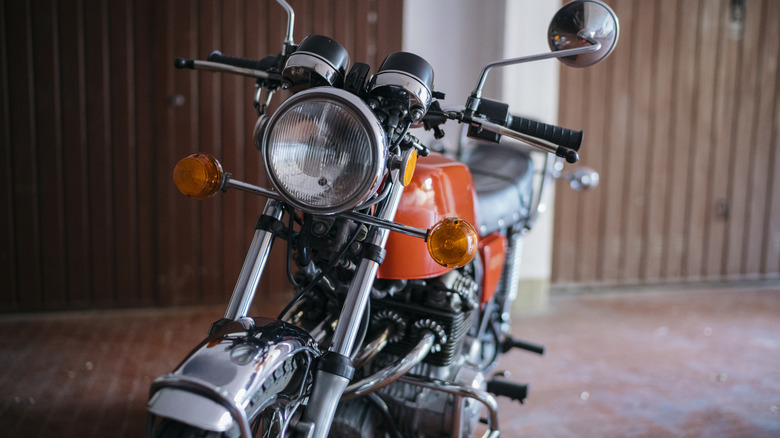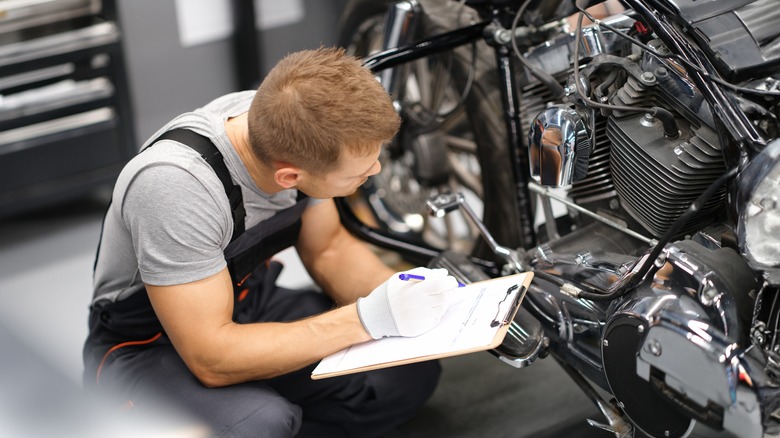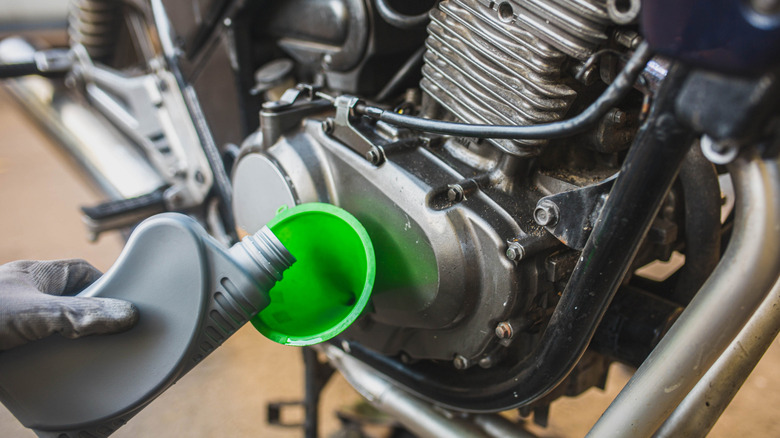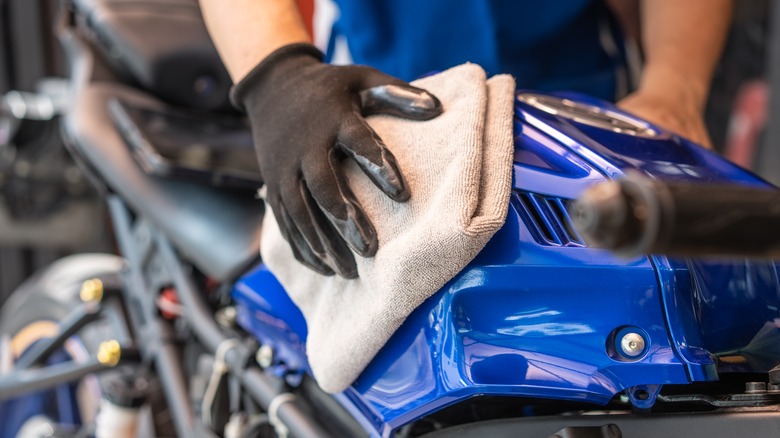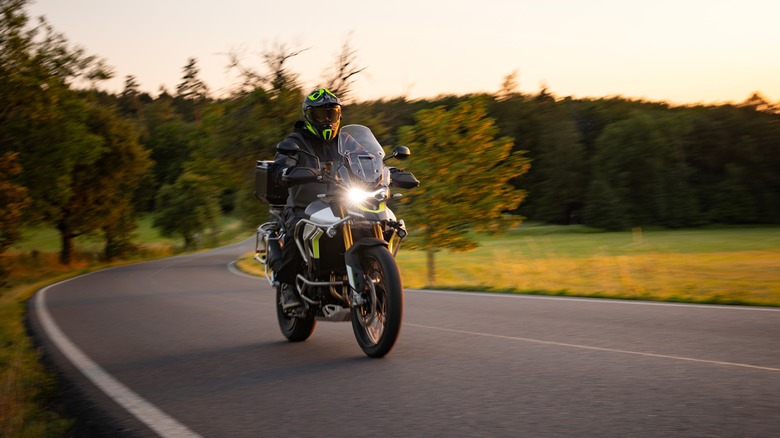5 Things You Should Do After Buying A Used Motorcycle
When buying a used motorcycle, whether from a dealership or a private seller, it's very important to do your due diligence and research before any money changes hands. It's the best way to ensure you don't end up with a lemon on your hands, after all. That said, no matter how thorough your research and questioning may be, there are some things you simply can't know about a bike until it's definitively yours.
You could say that the pre-purchase period is when you're supposed to be on the lookout for any major dealbreaker problems, while the post-purchase period is about getting into the nitty-gritty of what makes the motorcycle tick. At this point, it is your bike, and if you're going to be riding it on a regular basis, it would behoove you to know everything about it. In short, it's time to roll it out into the driveway, roll up your sleeves, and prepare to give it the looking-over of a lifetime.
Perform a thorough inspection
The first order of business is to perform a thorough inspection of the motorcycle, from the tips of the tires to the edge of the exhaust. It should go without saying that, prior to purchasing a used motorcycle, you should have a full, professional inspection done to catch any serious mechanical problems. After you've finalized your purchase of the bike, you should go over it with an inspection of your own, using the professional one as a baseline. Both a professional and personal inspection will help to paint a complete picture of what work your new used bike will need, if any.
Some preliminary tests include checking over the body for any obvious scuffs, scratches, or damage, hunting for any leaks in the seals, checking over the tires for wear or rot, and inspecting the inside of the fuel tank for corrosion. Basically, you want to inspect every single part of the motorcycle, moving or stationary, down to the finest detail. Even if everything seems fine at a glance, anything you miss could end up becoming a problem later. If there are any particularly small concerns like a little ding or an errant spot of oil, consider taking a picture of it with your phone so you don't forget about it.
Refresh the fluids
Once you're done with the preliminary inspection, the next order of business is flushing out and replacing all of the bike's fluid elements. No matter how friendly or reputable the seller you got the bike from may have been, you don't really have any way of knowing how long it was sitting in a garage, fluids swilling and congealing. If the fluids haven't been flushed in a while, even if they're fine right now, you might be in for a maintenance visit sooner than you would've liked.
Depending on the complexity of the bike, there may be more fluid elements you'll need to change out. Baseline, you'll definitely want to refresh the motor oil, transmission fluid, and brake line fluid. If the bike already has a lot of mileage on it, you should consider swapping out the fork oil as well, and if it has a coolant system, you should refresh that too. If absolutely nothing else, refreshing all of these fluids now will help to reset the bike's maintenance schedule so you can start getting used to caring for it.
Make a list of potential fixes and modifications to fit you
Normally, when you buy a new vehicle from a dealership, you can get different packages to better tailor it to your needs and preferences. This includes things like different seats, digital interface accessories, and so on. When you buy used, though, you may not get your choice of packages, especially if you're buying from a private seller. What you see is what you get, and even if most of a used motorcycle fits your profile to a tee, that doesn't mean all of it will.
Take another good look around the bike, this time noting down what you could add (or subtract) to customize it to your riding preferences. One major factor to consider is the seat — whether the bike still has its stock seat or some kind of aftermarket seat, if it's not comfortable for your particular ergonomic profile, it's definitely not going to be pleasant to ride. In a similar vein, you should give the handlebars a test grip to see how comfortable they are to hold. If it's not sitting in your hand right, swap 'em out.
Give it a good wash
The best way to show any vehicle you care about it is to give it a good scrub down. Your newly-purchased used motorcycle is now your responsibility, including day-to-day upkeep, so you might as well start things off on the right foot and clean it top to bottom. Get some motorcycle-safe cleaning solution, a couple of big buckets of clean water, and a soft sponge to carefully clean the entire body. If you noticed any oil stains, dirty or dusty spots, or localized rust during your thorough inspection, give those spots some dedicated attention to remove them entirely.
While you're in cleaning mode, it would also be a good idea to clean out or, if necessary, replace any standalone components. This can include dirty air filters and fuel filters, the inside of the engine, and if applicable, the fuel injection system. Make sure you only clean and service the components that you absolutely know how to do yourself; if there's anything you're unsure about, leave yourself a reminder to bring it up with a professional mechanic.
Take it for a spin
So, your new used bike is nice and clean and has been properly inspected and serviced. The only thing left to do is to take it out for a test drive. You probably took it for a drive at least once already before you purchased it, or at least you should've, but a pre-purchase ride isn't quite the same as a post-purchase ride, especially if you've already gone to the trouble of tuning and washing it. Something may have changed in the bike's operation between then and now, and you'll want to know if it has before you start taking it out for regular rides.
As you drive the motorcycle, continue to take mental notes about anything that feels off. There's only so much you can glean about a stationary motorcycle, after all; any remaining quirks will reveal their true colors once it's in motion. As for things to be on the lookout for, some examples would be unusual noises or shaking from the engine or exhaust, improperly-responding brakes, poor illumination from the headlights, or sluggish gear shifting. Obviously, don't make any physical notes while you're driving — either keep a mental checklist as you go, or pull over and stop before writing anything down.
